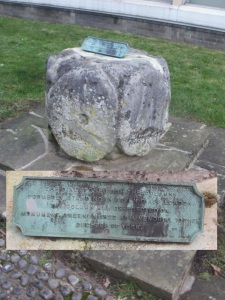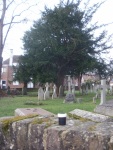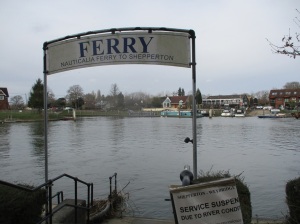Hello, Mrs Hg137 here.
At last, a few days without rain! Off we went to Weybridge, on the south-western edge of London, for some geocaching with firm, dry paths underfoot. After finding some free street parking, we made our way towards the town centre, and the parish church, St James: we needed to count some objects in the churchyard and then to use them to derive coordinates giving us the location of the Church Micro cache nearby.
While in the churchyard, gazing at an impressive tomb, musing, we were approached by a passer-by, who stopped to give an enlightening talk about the town and its history, which gave us information we would use for the rest of the day. The tomb is that of Princess Frederica Charlotte of Prussia – Duchess of York. A monument was erected to her – we’d visit that later, there’s another cache close by there.


Anyway, we worked out some coordinates for the Church Micro cache, a little way away, and decided to return to them later. We walked out of the busy town centre and through quiet residential streets, collecting some caches as we went. Looping back towards the town, we reached Monument Green. The monument commemorates the Duchess of York, whose grave we’d seen earlier. It was originally topped by a sundial which came from Seven Dials, in central London. This proved a bit top heavy, so it was removed and is now on display by the library; we saw it later, and it was waaay too heavy for that slender column. The adjacent cache was a milestone cache for us – 4500 finds !!! – and it’s a good location, an interesting place we wouldn’t have visited otherwise.
From the green, we headed north, passing some impressive pillars which used to lead to Portmore Park (it’s now a housing estate). We soon reached the river, at the confluence of the rivers Wey and Thames. Both rivers were high, just within their banks, and flowing fast. Just downstream was the Shepperton Ferry. This place brings back memories – back from 2015 when we walked the Thames Path (it’s the only ferry crossing on the whole, nearly 200-mile path). Actually, our main memory was of hanging around on the far side of the Thames for about 25 minutes, waiting while the ferryman finished his lunch (or whatever he was doing!). As the river was much, much higher and faster today, the ferry wasn’t running, but still a great spot and much reminiscing.
Passing D’Oyly Carte Island, we turned away from the river and followed wooded paths and fields back into the town. Once there, we realised we’d missed out one of the caches on our list (doh!), so back we went, to look for ‘Orinoco’s Favourite space’. We were expecting something to do with litter and Wombles, but, no, it was much-loved by the cache owner’s dog. While searching, we were hailed by a dog-walking muggle (non-cacher), wanting to know if we were doing ‘a survey’. Sort of, we said, and Mr Hg137 explained geocaching to him while Mrs Hg137 found the cache container.
Also, once here, we realised we were very close to the location of Oatlands Palace, now a housing estate, once home to Princess Frederica. We asked directions from a passing local and soon found ourselves at the surviving walls and archways of the palace. Very interesting, we wouldn’t have come here but for the local historian we’d met in the churchyard earlier.
Back to the church, to find the Church Micro we’d calculated the coordinates for at the very start of the day. Those coordinates (oh dear): we made not one, but two, howling errors, while working out the numbers, and spent some while searching an entirely wrong place, not once, but twice. We eventually started again, read the description properly and came up with some correct numbers which finally, finally led us to the cache. (One of us has a degree in ‘hard sums’: we should have done better!)
Close to the church is a park and allotments (unusual to have such a big open space so close to a town centre). while walking across the park towards a geocache, Mr Hg137 suddenly slowed, saying … ‘watch that man’ … he was just ahead of us, heading for a spot oh-so-close to where we were going, too. He bent down and picked something up; we walked up to him. Aha! a cacher caught red-handed! Good to meet you, Flyingfox76 ! Also good to meet you, mummycherub, who appeared very soon to ask to be added to the log. We swapped tales of caching, then went on our separate caching ways.
Our caching was nearly done now: we followed peaceful suburban streets to the south of the town centre, finding our last few caches, and returning to the geocar. We enjoyed Weybridge: it had far more to see than we were expecting, lots of history, attractive corners, rivers, parks, and glimpses of the past. A good place for a winter walk!
Here are a few of the lots of geocaches we found:



























































